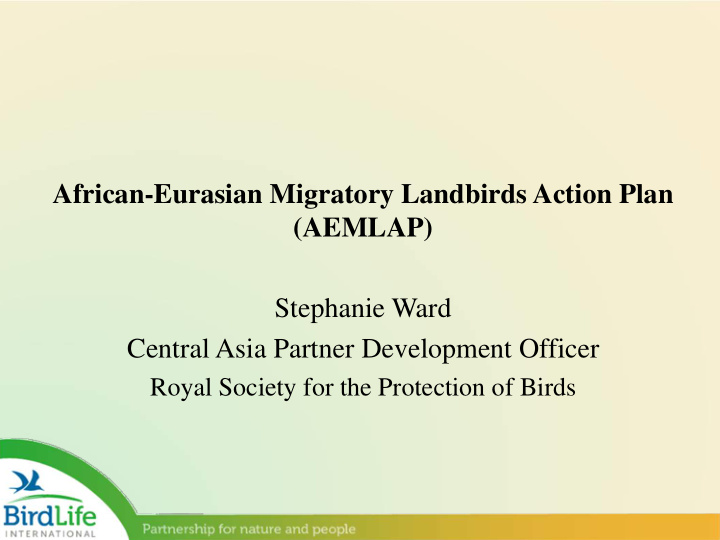



African-Eurasian Migratory Landbirds Action Plan (AEMLAP) Stephanie Ward Central Asia Partner Development Officer Royal Society for the Protection of Birds
The challenge • Migratory landbirds move across a broad front and depend on a variety of terrestrial habitats. http://education.randmcnally.com/
CMS COP10 in 2011 • Resolution 10.27 on Improving the Conservation Status of Migratory Landbirds in the African Eurasian Region adopted at 10th Conference of the Parties (CoP) of CMS.
AEML-WG and -SG • Working Group , technical and policy experts, comprising governments, NGOs, research institutions, development agencies, companies and individuals with considerable influence on migratory landbirds. • Steering Group , a closed subset of the WG, coordinating the Action Plan development and implementation process.
AEMLAP; agenda item 23.1.4. • Adopt AEMLAP and urge implementation as a priority. • Address habitat loss and degradation. • Implement existing measures under CMS AEWA, Raptor MoU and relevant international treaties. • Address unsustainable taking. • Implement guidelines to prevent poisoning. • Address key knowledge gaps. http://www.cms.int/sites/default/files/document/COP11_Doc_23_1_4_Landbirds _Conservation_African_Eurasian_Region_E.pdf
African-Eurasian international framework • AEMLAP complements the African-Eurasian Waterbird Agreement (AEWA) and Raptor MoU under CMS.
Region: 128 range states • Africa. • Europe. • Central Asia. • Middle East. AEMLAP Annex 2.
Species: IUCN SIS & BLI WBDB Dynamic list of full migrants that are principally ecologically dependent on terrestrial habitats, presently: • 34 GtB (category A), • 124 LC decreasing (category B), and • 346 LC increasing, stable or unknown (category C). AEMLAP Annex 3.
Thematic actions • Habitat conservation (agriculture, forestry, water, energy, climate change). • Taking and trade (legal and illegal taking, human-wildlife conflict, poisoning). • Other threats (diseases, collision). • Research and monitoring (migration connectivity, monitoring, capacity development). • Education and information (public awareness).
Migrant Landbird Study Group (MLSG) • An independent and international network of professionals and amateurs involved in the research, monitoring and conservation of migratory landbird species.
Friends of the Landbirds Action Plan (FLAP) • Provide support-platform(s) for information and experience exchange by the public aimed at AEMLAP implementation. • Internet. • Online social media. • Newsletter. • Apps. • SMS.
Species tool • Hosted within the BirdLife Datazone, enabling up-to- date information and filtering nationally and regionally. http://www.birdlife.org/datazone/species/search
Other implementation tools • Priority actions. • Species Action Plans (SAPs). • African Land-use Task-force. • European Atlas of Bird Migration (from ring recoveries). • Project portfolio. • Intersessional workshop.
Getting involved • AEMLAP is a vehicle for flyway-scale conservation policy, intervention, research, education and other actions, providing a platform for CMS focal points to link with colleagues in other ministries , NGOs , academia , development agencies and private sector . • This is driven by a strong and diverse network implementing actions using different tools locally, nationally and internationally. GET INVOLVED! Contact: temidayo.osinubi@birdlife.org
Recommend
More recommend